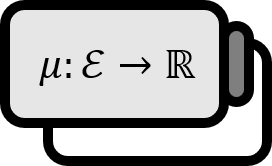The Mean Value of Locally Integrable Functions Converges to the Value of the Function at the Center.
Theorem1
Let’s say $f \in L^1_{\mathrm{loc}}$. Then, the following is true.
$$ \lim \limits_{r \rightarrow 0} A_{r} f(x)=f(x) \text{ a.e. } x\in \mathbb{R}^n $$
Here, $\text{ a.e. }$ is almost everywhere.
Description
The message here is that the limit of the average value of a locally integrable function’s value over the volume $B(r,x)$ as the radius goes to $0$ equals the function value at the center of the volume.
Proof
Since we take the limit as the radius of the volume goes to $0$, it suffices to show the following equation for some $N \in \mathbb{N}$.
$$ A_{r}f(x) \rightarrow f(x) \text{ a.e. } |x|\le N $$
For the same reason, we only need to consider the case when $r<1$. Then, as shown in the figure below, $|x| \le N$ and when $r<1$, $A_{r} f(x)=\frac{1}{m\big( B_{r}(x) \big)}{\displaystyle \int_{B_{r}(x)}} f(y)dy$ is determined only by $|y|\le N+1$, which are $f(y)$. Therefore, it is harmless to replace $f$ with $f\chi_{B(N+1,x)}$ and assume $f\in L^1$.

Lemma
Let’s say $f \in L^1(m)$ and $\epsilon>0$. Then, there exists a simple function $\phi=\sum\nolimits_{1}^Na_{j}\chi_{R_{j}}$ that satisfies the following condition.
$$ \int |f-\phi| <\epsilon $$
Moreover, there exists a continuous function $g$ whose function values are $0$ outside a bounded set that satisfies the following condition.
$$ \int |f-g| <\epsilon $$
$m$ is Lebesgue measure.
Now, assume that $\epsilon>0$ is given. Then, since $f \in L^1$, according to the lemma, a continuous integrable function $g$ exists that satisfies the following condition.
$$ \int |g(y)-f(y)|dy < \epsilon $$
Moreover, since $g$ is continuous, there exists $r>0$ that satisfies the following condition for all $x\in \mathbb{R}^n$, $\delta >0$.
$$ |y-x|<r \implies |g(y)-g(x)| < \delta $$
Moreover, since $\frac{1}{m \big( B(r,x)\big)} {\displaystyle \int_{B(r,x)} }dy=1$, whenever $|y-x|<r$, the following holds.
$$ \begin{align*} |A_{r} g(x)-g(x)| &= \left| \frac{1}{m\big( B(r,x)\big)}\int_{B(r,x)}g(y)dy -g(x) \right| \\ &= \left| \frac{1}{m\big( B(r,x)\big)}\int_{B(r,x)}g(y)dy -\frac{1}{m\big( B(r,x)\big)}\int_{B(r,x)}g(x)dy \right| \\ &\le \frac{1}{m\big( B(r,x)\big)}\int_{B(r,x)}|g(y)-g(x)|dy \\ &\le \frac{1}{m\big( B(r,x)\big)}\int_{B(r,x)} \delta dy \\ &= \delta\frac{1}{m\big( B(r,x)\big)}\int_{B(r,x)} dy \\ &= \delta \end{align*} $$
Therefore, $\lim \limits_{r \rightarrow 0} |A_{r} g(x) -g(x)|=0$. By the triangle inequality, the following is true.
$$ \begin{equation} \begin{aligned} & \limsup \limits_{r\rightarrow 0} |A_{r}f(x)-f(x)| \\ \le& \limsup \limits_{r\rightarrow 0} \Big( |A_{r}f(x)-A_{r} g(x)|+|A_{r}g(x)-g(x)|+|g(x)-f(x)| \Big) \\ =&\ \limsup \limits_{r\rightarrow 0} H(f-g)(x)+ |g(x)-f(x)| \end{aligned} \end{equation} $$
Now, let’s consider $E_\alpha$, $F_\alpha$ as follows.
$$ E_\alpha =\left\{ x\ :\ \limsup\limits_{r \rightarrow 0} |A_{r} f(x)-f(x) | > \alpha \right\} \\ F_\alpha =\left\{ x\ :\ |g-f |(x) > \alpha \right\} $$
Then, by $(1)$, the following is true.
$$ E_\alpha \subset \Big( F_{\alpha /2} \cup \left\{ x\ :\ H(f-g)(x) >\alpha /2\right\} \Big) $$
If an element belongs to $E_\alpha$, it must belong to either $F_{\alpha/2}$ or $\left\{x\ :\ H(f-g)(x)>\alpha/2 \right\}$. Therefore, the following holds.
$$ m(E_\alpha) \le m(F_{\alpha/2}) + m\Big( \left\{ x\ :\ H(f-g)(x)>\alpha/2\right\}\Big) $$
Moreover, by the definition of $F_{\alpha /2}$, the following is true.
$$ \begin{align*} && m(F_{\alpha /2}) \frac{\alpha}{2} & \le \int_{F_{\alpha /2}}|g-f|(x)dx < \epsilon \\ \implies && m(F_{\alpha/2}) &< \frac{2\epsilon}{\alpha} \end{align*} $$
Moreover, according to the Maximal Theorem, the following is true.
$$ m\Big( \left\{ x\ :\ H(f-g)(x) > \alpha/2 \right\} \Big) \le \frac{2C}{\alpha} \int|g-f|(x)dx \le \frac{2C\epsilon}{\alpha} $$
Therefore, we obtain the following result.
$$ m(E_\alpha) \le \frac{2\epsilon}{\alpha}+\frac{2C\epsilon}{\alpha}=\left( \frac{2(1+C)}{\alpha}\right)\epsilon $$
Since this holds for every $\epsilon>0$, we obtain the following.
$$ m( E_\alpha)=0 $$
$$ \lim \limits_{r\rightarrow R}\phi (r)=c \iff \limsup \limits_{r\rightarrow R}|\phi (r)-c|=0 $$
Therefore, for $\mathrm{a.e.}$ $x\in\mathbb{R}^n$, we obtain the following.
$$ \begin{align*} && \limsup \limits_{r\rightarrow 0} |A_{r} f(x)-f(x)| &= 0 \\ \implies && \lim \limits_{r \rightarrow 0}A_{r}f(x) &= f(x) \end{align*} $$
■
Gerald B. Folland, Real Analysis: Modern Techniques and Their Applications (2nd Edition, 1999), p97 ↩︎
